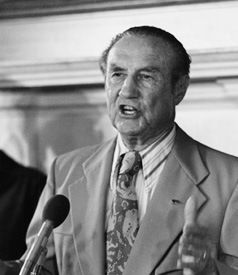It has been said and rightly so, history has a way of repeating itself. The British philosopher Edmund Burk said, “Those who don’t know history are destined to repeat it.”
This Tuesday, November 2, as Americans go to the polls they face a real challenge. Making an intelligent informed decision amid all of this partisan, ideological, rhetoric is a daunting task. Many attribute this dissension and rancor to the election of President Obama, the rise of the Tea Party and the refusal of most Republicans to work with the president on any level that would result in positive policy output for the country. It’s much, much deeper than that.
When you take a step back and look at our political landscape from a broader historical perspective, what you see is that our current dysfunctional situation is not a recent development, but the culmination of a conservative backlash that can be traced back to 1948 and the rise of the States’ Rights Democratic Party, which quickly became known as the Dixiecrats.
The Dixiecrat Party was formed after 35 Democratic delegates from Mississippi and Alabama walked out of the 1948 Democratic National Convention. These delegates were protesting the adoption of Sen. Hubert Humphrey’s (D-Minnesota) proposal of civil rights planks calling for racial integration and the reversal of Jim Crow laws in the party platform.
They met in Birmingham, Alabama, and nominated Gov. Strom Thurmond of South Carolina for president. They opposed abolition of the poll tax, while endorsing segregation and the “racial integrity” of each race. Their campaign slogan was “Segregation Forever!” and their platform also included the call for “states’ rights.” Like the modern day Tea Party, the Dixiecrats called for freedom from governmental interference in an individual’s or organization’s prerogative to do business with whomever they wanted. Thurmond received more than one million votes in the 1948 election, won four states and 39 electoral votes.
The Institute for Research and Education on Human Rights report “Tea Party Nationalism: A Critical Examination of the Tea Party Movement and the Size, Scope and Function of Its National Factions” says from the outset, “… the majority of Movement supporters are people of good will.” But integrated into their calls for a reduction of the budget deficit and smaller government are concerns about race, sexual orientation, national identity, national birth rights and who qualifies to be an American. As the Tea Party Movement has taken shape amid this fiscal rhetoric; racist, white nationalist, anti-immigrant, homophobic and anti-Semitic elements have found their way into the “Movement.”
Tea Party’s keynote Sarah Palin calls for “states rights” and says, “it’s pretty simple. It’s a smaller, smarter government, not growing government to control more of our lives and our businesses and make decisions for us.” This sounds a lot like a page taken right from the Dixiecrat playbook.
The Tea Party, like the Dixiecrats, is not for as much as it is against. In his book White Nationalism Black Interest, the late Dr. Ronald Walters described the politics of resentment. A resentment of African-American demands for social justice and the federal government’s sanctioning the institutionalization of these rights resulting in a large number of whites becoming cynical about government and alienated from it. They are resentful of this “big government” exercising too much control over their lives. This resentment also applies to the anti-immigration and anti-gay and lesbian rights rhetoric of the Tea Party.
Independent journalism is important. Click here to get Truthout stories sent to your email.
Some wonder whether the Tea Party will have any impact on third party politics going forward? Not really. Palin has stated, “… because the Tea Party movement is not a party and we have a two-party system, they’re (Independents) going to have to pick a party and run one or the other: ‘R’ or ‘D’.”
The Dixiecrats only lasted about four years. By 1952, most of them returned to the Democratic Party and formed a very strong Southern bloc. They remained in the Democratic Party until Republican conservative Barry Goldwater liberated them in 1964 by articulating some of the Dixiecrat ideologies in his politics.
Based on Walter’s politics of resentment, there have been other groups and movements based primarily in ultraconservative politics and aligned with reactionary politicians. For example, Nixon’s “Southern Strategy” and the Silent Majority, the “forgotten middle-class” of the 1970’s, the Moral Majority, the Christian Coalition and from there the latest manifestation is the Tea Party Movement.
This Tuesday, November 2, as Americans go to the polls they face a real challenge. History does have a way of repeating itself and unfortunately, too many people don’t know their history.
Join us in defending the truth before it’s too late
The future of independent journalism is uncertain, and the consequences of losing it are too grave to ignore. To ensure Truthout remains safe, strong, and free, we need to raise $24,000 by the end of today. Every dollar raised goes directly toward the costs of producing news you can trust.
Please give what you can — because by supporting us with a tax-deductible donation, you’re not just preserving a source of news, you’re helping to safeguard what’s left of our democracy.
